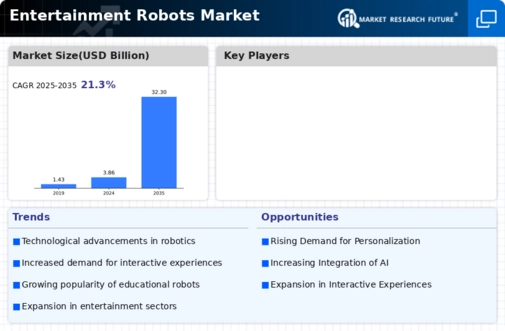Top Industry Leaders in the Entertainment Robots Market

The Competitive Landscape of the Entertainment Robots Market
The entertainment robots market, paints a vivid picture of a future where technology dances with imagination. These nimble performers grace theme parks, museums, and living rooms, captivating audiences with their interactive antics and mesmerizing movements. Delving into this dynamic landscape requires a lens focused on the strategies, factors, players, and trends shaping its trajectory. Understanding the competitive landscape in this dynamic market is crucial for players seeking to tap into the growing demand for robotic entertainment.
Some of the Entertainment Robots companies listed below:
- Kuk
- Hasbro Inc.
- Mattel Inc
- Sphero
- Bluefrog Robotics
- Modular Robotics
- Robobuilder
- Sony Corporation
- Lego
Strategies Adopted by Leaders
- Technological Prowess: Leading players like Engineered Arts, Walt Disney Imagineering, and Boston Dynamics invest heavily in R&D, pushing boundaries in robotics, artificial intelligence (AI), and human-robot interaction. They pioneer technologies like advanced locomotion systems, expressive facial features, and natural language processing, creating robots that blur the lines between machine and performer.
- Application Focus: Players cater to specific segments within the entertainment industry. A.I. Factor specializes in interactive robots for theme parks and museums, while RoboThespian excels in theatrical productions and live performances. This specialization allows for tailored capabilities and deeper engagement with specific audiences.
- Content Creation and Storytelling: Weaving compelling narratives and developing engaging routines is crucial for captivating audiences. Companies like Sphero and Anki combine advanced robotics with interactive apps and storytelling elements, creating immersive experiences for children and adults alike.
- Accessibility and Affordability: Making robots accessible to a wider audience is key to market growth. Hasbro and Mattel offer affordable robotic toys for children, while companies like Blue Frog Robotics develop educational robots for schools and libraries.
- Strategic Partnerships: Collaborations with entertainment companies, technology giants, and research institutions accelerate innovation and broaden market reach. For instance, partnerships between robot developers and theme park operators enable the creation of immersive and interactive experiences.
Factors for Market Share Analysis:
- Robot Type: Analyzing market share by robot type (humanoid, animal, educational) reveals dominant players in each segment and future growth potential. Humanoid robots remain the most popular due to their anthropomorphic appeal, while educational robots are gaining traction due to their potential for interactive learning.
- Target Audience: Understanding the needs of different audiences (children, adults, families) is key. Children's robots prioritize entertainment and educational value, while adult-oriented robots may focus on interactive experiences and novelty.
- Control and Interaction Methods: Analyzing market share by control methods (remote control, voice control, AI) helps identify leaders in each segment and future trends. AI-driven robots offer greater autonomy and interactivity, but remote-controlled robots may be more suitable for specific applications.
New and Emerging Companies:
- Pepper: This humanoid robot from SoftBank Robotics offers social interaction and emotional intelligence, catering to the growing demand for robots that can connect with humans on a personal level.
- Ozobot Bit: This educational robot from Ozobot combines coding and robotics, offering a fun and engaging way to teach children about STEM concepts.
- Cyberdyne Tech Robotics Systems: This Japanese company specializes in humanoid robots with advanced mobility and dexterity, pushing the boundaries of what robots can do.
Industry Developments:
The world's first interactive robot exposition, called RoboShow, will debut in 2023 thanks to Dubai-based RDI Robots, a producer of robots that specialises in autonomous service robots. The goal of RDI Robots, which has its headquarters in Dubai and a global development team, is to develop a platform for universal robotics that will shape future interactions between humans and robots.
The newest iteration of its agile intelligent robot dog, Lite3, will be released in Europe in 2023 by DEEP Robotics Co., a pioneer in the development and industrial application of quadrupedal robots. Lite3 combines advanced mobility and an open modular structure to support education, research, and cutting-edge entertainment.
In 2023- Owners will be able to donate their unwanted Aibo robot dogs to Sony's new foster programme, which will place them in a new home. According to a Sony release, the Aibo Foster Parent programme intends to increase the sustainability of the four-legged robot companion and meet the rising demand. The business claimed that after getting "many inquiries" from Aibo owners who no longer required the robot, it began the programme.
